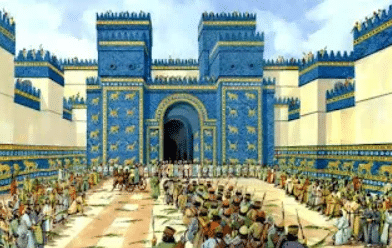Atonement , then Trumpets , and the third day Booths (?) : the ’12 days for 12 tribes’ [Num.7] and the Assyrian Akitu 12-day feast in Spring ánd Fall about destroyed Eden [2025-10oct.27] |
| content … it seems a stretch to make ‘the week of Booths’ into a period of ‘twelve days’ — but if we don’t want to wait another year we have no other option now , and curiously enough this option seems possible based on the Assyrian Akitu festival in combination with mysterious chapters as Numbers 7 , remembering that ‘the sanctification of Aaron’ who represented the 144 having ‘to wait for seven days at the door’ which per context may have been ’12’ … |

|
theme
… any new concept always needs a bit of time to settle , is it not , just like a month ago
showed the curious theme of “the Eden star tabernacling in the summit of his sceptre” ,
and though that concept itsélf has not changed we need to review the ‘three days’ here
and see how they would fit in this period , if we would try a base-12 for the Fall feasts —
we know that the ‘7’ (-Unleavened days) is an important feature of the Spring feasts ,
yet our first problem is ‘do they both need to be seven days long’ ?
because our intuition says ‘yes’ , but mainly because it feels ‘balanced’ ,
but what if there was another component intended in the Fall feasts ?
is “a 12 day Atonement feast” really less credible as the “7 day Unleavened feast” ?
we know that the ‘7’ is God’s sacred number and we would want to maintain that in the
Spring feasts which are the blueprint , but curiously the Spring feasts seem to contain
the number ’12’ — as foreshadowing already ? :
first month seventh month
10th [selecting the sacrificial animal]
14th Passover
15th start of Unleavened week
16th Firsfruits
21st Unleavened main seventh day
12 days total >> 12 days here ?
though it was a while ago , please remember Adam’s curse as his ‘seven-fold revenge’
that he swore against Eden combined with his own malevolent number ’10’ which both
show in the Spring feasts , where God undoes Adam’s illegal combination ’10 x 7′
and has selected Adam as sacrificial animal on that ’10th’ of the Great Jubilee year —
yet since the Fall feasts are about us , where is the ’12’ as base of the 144,000 ..?
we understood rightly that ‘Atonement’ was all about “the 144 dying to self” as having
followed the example of Christ at the time of Passover , right , so that it is not illogical
to look where ‘our’ number (’12’) then could appear here : because now it doesn’t !
how curious is that ?
the Fall feasts are important in this sense that the died (Jacob-) souls will have done
what evil Adam refused to do – and yes they could only do so because Christ did –
with a similar curse by Adam upon them since he nefariously leveraged the ’12’ with
his ‘factor 1000′ (from ’10’) in order that such a high number of males and females
would never ‘succeed to die’ !
and indeed it is an outright miracle that this did happen – Sir – but would not that be
followed by ‘some type of declaration of God about that situation‘ ? about the
only time in the history of this prison-planet announcing the restoration of Eden ?
say “in a series of 12 days in which those same 144,000 would be sealed” or who
knows “12 days when their names are written down — before being sealed” ..?
the more you think about it please the Fall feasts MUST have contained a ’12’ …
the curious ’12 days for each of the 12 tribes’ (-in Numbers 7)
… we’ll get back to that chapter but her context is important at this point ,
and to not confuse the buildup we look at the Assyrian Akitu festival only after this :
in
(1)
“And it came to pass on the day that Moses had fully set up the tabernacle, and had anointed it,
and sanctified it, and all the instruments thereof, both the altar and all the vessels thereof,
and had anointed them, and sanctified them “
… after which , in the Esau version ,
during “twelve days the heads of each tribe makes a donation to the Tabernacle” —
but does that make Sense ? what if this was cut-off from the ‘sanctification of Aaron’
event which indeed ‘literally’ happened as we saw — but as ‘foreshadowing’ of the 144 ,
where now He explains to Moses “how that foreshadowing will work out in the future” ?
(11)
“And the LORD said unto Moses, They shall offer their offering, each prince on his day ,
for the dedicating of the·altar (!).”
… how much is the chance that ‘the offering’ by the 144 is ‘their death to self’ ?
and knowing it is the greatest gift a soul can give ,
Esau’s cursed neverending ‘money theme’ as “gifts of silver and golden spoons”
are an outright nasty and silly offense as another of his plausible deniabilities ;
at this point ,
he starts to use the word “dedication” (-chanukkah) which by all means can be his
corruption of ‘will be sealed’ (-chthm) since they áre already ‘sanctified’ by this time ,
causing an interesting link to his invented ‘Hanukkah feast’ — see the section below
were also ‘the attributes’ of each tribe mentioned ?
the chapter is so lethally corrupted by Esau that it’s hard to see – but it’s very possible ,
because listing the tribes could include the attribute that they will have brought back
that should be all the themes He mentioned in prophets —
these can have appeared in “the blessings Jacob gave to each of his twelve sons” in
Gen.49 and Dt.33 yet the text is so lethally corrupted that it’s hard to recognize most
of the themes : at ‘Judah’ still shows “the (Eden-) sceptre” while ‘Joseph’ seems to
represent “the birthright theme” ; Benjamin (-if it was his real name !) wasn’t linked
to ‘wolf’ but most likely “the (Eden-) star” (zeB=kkaB) because it’s the final attribute
while Joseph was hellbent “at having Benjamin at his court as well” ;
yet sadly the other descriptions are so maimed that we can only guess — even though
we can think of ‘the seven Torches’ and ‘the corner-stone’ and other attributes which
must have belonged to each of the nine remaining tribes ,
for Esau made a canon for his repeated tripe like “[his gift was] one silver charger with
a weight of a hundred and thirty [shekels] , one silver bowl of seventy shekels after the
shekel of the sanctuary [and] One spoon of ten [shekels] of gold, full of incense:” blah ,
so that the original Attributes in those totally corrupted lines are unrecognizable now ..
the ‘declaring by God about the 12 tribes during these 12 days’ – right now ?
… considering the above aspects , please ,
though it is horrifying to have to say “we don’t know for sure” simply because nothing
even remotely indicates this , even we do believe that you & we were meant to study
this option (-yes after the other concept had crumbled) ,
we still have the problem of ‘the buildup’ of the Fall feasts —
did it start with “twelve days of Atonement” ? not only per this Numbers 7 chapter
but combined with the “Aaron waiting at the gate for seven [=12] days” ?
followed by ‘the day of Trumpets’ ? and “Booths as closing at the third day” ?
’12 days’ seem possible :
… now for how long we are fighting with this ? – but only because of corruption :
the sanctification of Aaron was a ‘literal’ event as foreshadowing , and where KJV
has him “waiting seven days at the entry of the Tabernacle , and the eighth day..” ,
not only we can make that a realistic ’12’ days as each day for every tribe , [reason #1]
but it also suggests “a next important day” (Trumpets ?) so that is good ; [reason #2]
while ,
where in the “Fall of Jericho” Joshua chapters they first do Atonement
(but which was corrupted by Esau into his ‘circumcision’ fallacy) the text-buildup
of the blowing the trumpets of suggested the day of Trumpets + 3 days ;
or better ‘Trumpets – and on the third day ..’ when probably not the·wall (!) of the [reason #3]
city fell flat but “her gate was blown out” as Adam’s gate that will be imploding ;
15 days , until the next new (full-) moon .. is that significant — at the start of the
Eden month ? it could be : since the main theme of the Assyrian Akitu festival [reason #4]
starting at their new (empty-) moon was about the fall of Eden
Akitu festival – in the first and seventh month
… as New Year feast this twelve-day celebration was held in the first month (Nisan)
but curiously – or not – repeated in the seventh month as confirmed in a clay tablet
saying “.. on the 8th day the gate (of the temple) is kept open and the procession of
Bel sets out as in the month Nissannu (‘first month’). [The cerem] onies of the city of
Dêr are conducted in the same manner.” [1] ;
| and combined with the contents of this feast it already suggests that their overlords in the city mystery-Babylon anticipated that God would present his series of feasts supporting the traject of undoing the fall of Eden ; |

|
its origin was the Sumerian Zagmuk feast
also of twelve days carrying the same theme
where Marduk conquered Eden though there
isn’t much literature concerning Zagmuk ;
the Akkadian ‘Akitu’ has better documentation — and though not every action is clear
they do make Sense when we place them in the same perspective (contents taken
from the link at end of page) :
day 1 : preparations
— priest comes down to the courtyard of Bel with a key (‘chisel’?) [opening of Eden gate ?]
[‘to open a cistern and throw spomething in it’ ?]
a fragment has “they have not looked upon the axe” [3] suggesting
that the axe (‘chisel’) waas displayed in the Akitu house
— gates are purified by smearing oil on them [sic , compare Passover]
[related to ‘the opened eden gate’ ?]
day 2 : customary rites
day 3 : fashioning figurines [us ? see day 6]
day 4 : sceptre presented to king & reading of Enuma Elis [‘Eden destroyed’]
— a blessing of the Aesagil (‘temple complex’) as image of the star ikû
— full text of Enuma Elis recited
— king goes to Nabu’s “sâ harê” temple (‘house bestowing the sceptre of the land’)
to receive the sceptre of kingship ,
so that there is a “star & sceptre” theme here [star & sceptre]
day 5 : purification of temple & vindication of the king [kind of atonement ?]
— a sheep slaughtered & blood for to cleanse the temple ,
and the carcass thrown in Euphrates ; then the priest leaves for the open country [3]
doing the same (same what?) with the head of the sheep and is not allowed to enter
the city from the 5th until the 12th day
[this looks like “the animal sent into the desert , at Atonement” :
was that act original – or inserted by Esau taken from the Akitu festival ?]
— the king vindication ritual : he had to declare “that he had not harmed Babylon”
as invoking the blessing of Marduk for another year – or not ;
— a bull offered (-but happened over several days w/ many offerings)
— a ‘cry of distress’ was uttered (-but is not explained) [Trumpets related ?]
day 6 : Nabu (‘Thoth’) arrives
— the two figurines (of day 3) are symbolically killed [two houses / 144 ?]
day 7 : clothing ceremony [stolen aspects of our Originals ?]
— seems specific of the ‘seventh-month Akitu’
day 8 : divine assembly & procession to the akitu-house
— decreeing the fates & destinies [star / birthright theme]
day 9 : omens (?) & celebration
day 10 : gift giving
day 11 : divine assembly & returning procession
— second decreeing of fates
— “… On the 11th day , A [ssur rises and] sits down [on] his [seat in Esarra] ” [Booths]
[this was the same as ‘Marduk in the seat of Tiamat’
that is “the dimensional mid-region that was ‘of Eden’ previously]
day 12 : return to home cities
— “the 12th day that Bel departs” [3] xxx
THE main question would be “how did they get to this 12” , right ,
so that they must have known that 12 was ‘our number’ (and compare the Spells
where they continuously copy that ’12’ into a double) where the buildup does not
only proclaim a victory but the same time is a defensive (occult-) Ritual ;
especially because of the two unknown figurines then destroying them at the third
day that must be about ‘the 144’ that first “came into being upon this earth” and as
if made ‘by them’ — which is kind of true because of this ape 2.0 body ;
where their “dressing up” in next day 6 may refer to “the stealing of aspects of our
Originals” because ‘if they keep destroying us then their own people can continue
to be dressed with the (stolen-) the garments’ , no ?
the entire ritual is one of solidifying their victory over Eden
and the aspects are só similar to our Spring & Fall feasts that it’s unmistakable ,
so that we need to ask “in what way Esau – who knew this – changed the Scroll ..?” ;
in our opinion ,
he first would have demolished the entire structure of the Fall feasts that are
in sequence like the Spring ones , then have removed the subject (‘the 144’) ,
have obfuscated the goal (‘restoring Eden’) together with its won Attributes ,
and finally – probably – have turned all into some lame copy of the Spring feasts :
is that not what seems to have happened ?
so that we not only have “a moved day of Trumpets” and that “of Atonement”
but not even “the week of Booths” is true because “the 12 days of Atonement”
where after the third day was “the great final day of Booths”
as the very moment that the Eden booth is to be entered and restored :
how awful Majesty that we have no shred of any proof for all of this except for
looking at the context and knowing – and hoping – that you are not agáinst us ;
who in the world please risks to question everything ,
because all we need is that you get us out before we or the situation kills us ?
additional Akitu texts
a text of Nebuchadnezzar has ,
when the last of four renovations mentioned that take place in the Esagila (‘temple’)
the “throne dais of destinies” is described as existing in the Ubšu-ukinna, that is the
“gathering hall of fate, wherein at the zagmuk (the Sumerian version of the feast)
in the beginning of the year, on the 8th and 11th days of the month, the king of the
gods of heaven and earth, divine lord, sits… where they decree the days of eternity
and the fate of my life” (15 ii: 55-64). The renovation involves adorning the dais in gold
rather than the silver clothed by a former king; additionally utensils (unūtu)
and the Ku-a-boat are decorated” [2] ;
where this boat likely is the same as the makurra in Nebuchadnezzar no.19 , where
cuneiform literature describes the Makurru as a big cargo vessel that sailed the rivers
and seas of Mesopotamia — aka the “Magickal Boat” in the Spells , mystery-Babylon ,
full of stolen Eden goods (the ‘cargo’) , again supporting the main theme of this festival ;
Nabonidus (no.8) has ,
how after his ascension to the throne, acceptance of Nabû’s scepter and prayer toward
Marduk to accept his kingship, his adornment of the temples in Babylon (8 iv-viii) :
on the 10th day of the Nisannu, while the gods were in “the Akītu-house, the ‘house of
the blessing’, the leaders of the Akītu-house” (akīti enliltu), Nabonidus gives 100 talents
21 minas of silver, 5 talents 17 minas of gold to Marduk, Nabû and Nergal (8 ix: 3-30).” ,
where the sceptre represents ‘the stolen (Eden-) birthsceptre’
that he has to defend against Jacob — and showing the amounts of money here to see
whether (and in how far) Esau may have copied aspects of here into the Scroll ;
[this one case – Esau’s corruption ? :]
you will forgive please that this is a bit long section ,
but to show how dangerous this matter is :
through a found tablet scholars linked a shown action to the month of Kislev (the 9th)
which however would be fatal for us — fatal for our Fall feasts concept ,
because of the infamous “24th of the 9th” date in prophets (Haggai & Zechariah) which
Esau linked to his completely invented “Hanukkah” feast from Christmas + 8 days on ,
having costed us much trouble before finally renouncing it —
however ,
the below lines of a clay tablet and the interpretation of it would completely undermine
the case of the Fall feasts containing the 12 days and have us scramble to find some
solution including that ‘9th month’ again ;
this is the text section [2] ,
“there exists in the collections of the British Museum a large tablet [BM 32206+?]
doubtless forming part of the ‘festkalendar’ of Babylon, which gives in several columns
detailed instructions about the cultic ceremonies performed in Babylon both in Tašrītu
(‘7th month’ of the Fall Akitu) and the immediately preceding and following months…
[The text] goes on to state that a great meal was offered to Bēl following the opening of
the gate, and a couple of lines later tells that sections from Enūma Eliš were recited to
Bēl by a chanter (nâru) on the same day.” ;
[…..] In the text mentioned above, BM 32206+, this reading by the nâru serves a special
purpose [:] when the line v: 83 is reached , mentioning the carrying of a present from
Marduk’s mother (sic) to Marduk as an expression of thanks for his victory over Tiāmat,
the dumuniglala-priest re-enacts this line by presenting a palm frond on a silver tablet to
Marduk, a further emphasis on Kislev as a palm festival.”
[those lines read : V 81-84: “Mother Damkina, who bore him [Marduk] , hailed him, with a
clean festal robe she made his face shine. To Usmû, who held her present to give the
news, [he entrusted] the vizierate of the Apsû and the care of the holy places.”
here ,
the ‘mother Damkina’ is ‘the virgin of tsiun’ because Marduk is the same as Enki (‘Horus’)
and the ‘garment’ is their stolen body by the Eden mother ;
but after searching only two vague unattested Assyrian ‘Kislev celebrations’ showed up
where ‘palm’ makes no sense there apart from being ‘a grove’ slightly linked to Ishtar ;
yet about that same tablet the same author [as link 1] remarked ,
“BM 32206+ is a Late Babylonian text describing rituals performed primarily in the month
of Kislev. Based on paleographic features the tablet can securely be dated to the Hellenistic
period – however , when [..names..] first published the text (‘see quotes above’) they claimed
that its original composition dated back to as early as 800 BCE and pointed out that the
‘copy’ with which we are dealing is pervaded by ‘textual corruption’ limiting our understanding
of the text’s contents. Despite that […] [it] is frequently quoted and used in modern studies [..] “.
[But] I claim that the ritual text’s origins can be firmly anchored in a Hellenistic setting.
Placing it against this historical background also sheds more light on the question of “who it
was (good) for” as it exposes the text as part of a discourse that gives an unprecedented
central role to Babylon’s priesthood (Late Babylonian priestly literature)” [3]
and that makes sense :
after Nebuchadnezzar (who captured the Scroll !) at the time of Cyrus the Akitu festival
was in decline [see 2] and her final remark about ‘the unprecedented role’ is telling since
that can only be Esau as the ones now becoming the new ‘priestly class’ introducing the
new common religion of “against the Scroll” that he had started to corrupt ,
and the same time wiping out any ancient religious traces that could hárm his case ;
where indeed his final redacted corrupt scroll was done during the Hellenistic period in
Egyptian Alexandria when he produced ‘the Septuagint’ : today’s evil KJV !
curiously – or not ,
some aspects just don’t sit right in this tablet like “the 12 breads offered to Marduk”
which feels to be linked to his “twelve shewbread” corruption in the Scroll ,
and likewise “presenting a palm leaf on silver platter to Marduk” makes no sense at all
but sounds like his allegedly “silver platter offered by each of the 12 tribes” while the
palm leaf itself even as ‘victory sign’ makes No sense in the context of the eden mother ;
these details are so different from the ‘sensible’ actions we saw described that it looks
as if Esau wanted to create a ritual link to Kislev where not much later he invented
his ‘Hanukkah’ fantasy — and please remember his term ‘hanukkah’ in Numbers 7 ! —
but in reality linking to THIS theme ,
where his ‘Hanukkah’ is described as “based upon the feast of Booths” but with the
intent to cover it with Adam’s Strange Fire offering (the ‘altar aspect’ of his invention) ;
and behold ,
mid-500 AD one of his Gnostic goonies invented ‘the 12 days of Epiphany’ running
from Christmas day (whatever is true of that) until January 6 supposedly linked to
a ‘baptism of Christ’ (=false) or ‘the three magi’ (=which is the Eden star theme) ;
either way invented to have his (!) Western RCC christianity with Eastern Orthodoxy
supporting his ‘Hanukkah’ invention because of the same Ritual Link ,
and even though the contents óf that alleged Epiphany period are shallow as Hell ,
the name itself means ‘appearance’ – namely ‘of Christ upon the clouds’ because
this originally was the promise after “the 7 (12) days of the sanctification of Aaron”
namely “that IEUE will APPEAR to you” ,
showing that Esau moved the key aspects to his contrived ‘feast’ in the 9th month … xx
annex :
Celine Debourse ;
very well written & with much care
[2] Balancing Power and Space:
a Spatial Analysis of the Akītu Festival in Babylon after 626 BCE
[3] Projects and Publications – RITM – Rituals and Texts in Mesopotamia
[further]
The Akitu-Festival – THE BABYLONIAN NEW YEAR´S FESTIVAL



























